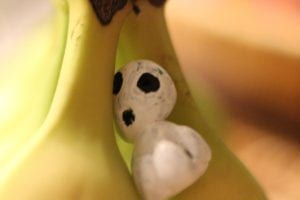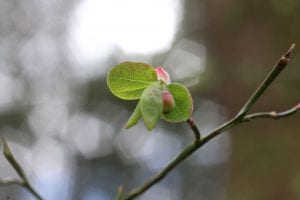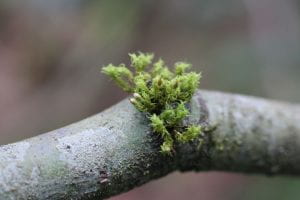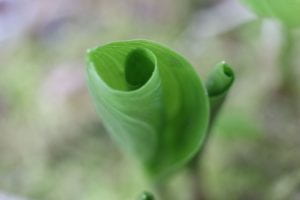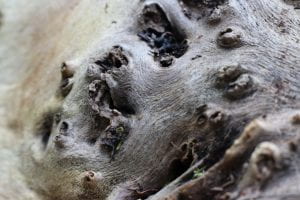We’re now entering the final stretch of In-Depth 2021! As we approach In-Depth night, I’ve begun to work on my three collections, testing out ideas and concepts for each one.
March 12, 2021:
For my second collection, I required a little figurine to photograph, so I made one out of polymer clay. The figurine is supposed to be a Kodama (Japanese tree spirit), inspired by the depiction of Kodama in the film Princess Mononoke. I constructed the figurine out of polymer clay and then painted it. Unfortunately, I forgot to take photos of the design and construction process.
March 14, 2021:
I took a few concept/practice photos for my second collection. I worked indoors for this set of photos, so I had to be mindful of lighting issues. Something else I found was that I could only take a limited variation of photos. Because my figurine is made of clay, I can’t really move or pose the limbs. This might result in the photos for this collection looking kind of repetitive. For that reason, I might make more figurines of my character in different positions (standing, lying down, expressions, etc). Here are a few of the photos I took:
April 4, 2021:
I went on a walk with my mentor and took some photos for my forest-themed collection. I was able to capture a lot of the new spring leaves and flowers! I also tried to take pictures of a live subject (a fly) for the first time, but it was too difficult because my subject could probably sense that I was trying to capture it so it kept flying away. Here are some of the photos:
- Concepts
How to Have a Beautiful Mind stresses the relevance that concepts have on our thinking. On page 121, the author Edward de Bono compares concepts to “parents that breed children” and “road junctions that open up several other roads.” When learning new information, it is important to understand the essence or concept behind the narrative. From a concept, ideas are generated, followed by the importance or usefulness of these ideas. Naturally, the average person doesn’t really think to assign or develop concepts to various topics. For that reason, this practice will become a lot easier once the act of spotting concepts is learnt. According to How to Have a Beautiful Mind, one of the key components of concepts is that they “always seem rather vague” [pg. 112]. This is because a concept must travel through the path (concept to ideas to uses) I mentioned above to be applied. Although most concepts are vague, concepts can range from broad to narrow. In terms of usefulness, look for concepts that are in the middle of the spectrum.
List some examples of concepts in your most recent sessions with your mentor.
- Art: photography falls under the broad field of art
- Style: how people artistically portray their subject, style, or vision. When creating collections and doing photography in general, developing a personal style is quite important.
- Nature: macro photography, which is the specific form of photography that I’m focusing on, often finds its subject matter in nature
- Subject: what each photo is depicting.
- Story: about what each photo has to tell its audience
- Interest: what kinds of photos are more likely to garner attention and admiration?
- Alternatives
When it comes to learning something new, what most people typically value or look for is growth and development. Growth is a sign of progression and experience. None of these things can occur without some form of movement or fluidity. How can anything be accomplished without some kind of mental or physical movement? Letting go of rigidity is the best way to accomplish this. How can one do this? Through alternatives. Similar to compromise, finding alternatives requires open-mindedness. Just because you’re used to one way of doing something doesn’t mean that other ways or alternatives aren’t just as good (or even better). In How to Have a Beautiful Mind, three main types of alternatives are highlighted: “alternative perceptions or ways of looking at something…alternative sets of values determined by experience, culture and personality…alternatives of action” [pg. 136].
What alternatives have your mentor offered you throughout this project? What alternatives may another mentor have offered you? Discuss in detail.
Alternatives my mentor’s offered me:
- Tripods: when I’m taking photos outdoors and don’t have as much control over the height of my environment, it can be quite tricky to photograph subjects that are drastically above or below my eye level. This is because I have to hold the camera in very awkward positions, so my hands shake quite a bit when I’m taking the photos and as a result, there’s a higher chance of the photos turning out blurry. As an alternative to trying to take photos using myself alone, my mentor has provided a tripod so I don’t have to worry about shaky hands.
- Different locations for photography: When we started our sessions, my mentor and I would often look for places to take practice photos. These locations usually had to be outside, as you might recall from earlier posts that indoor lighting is often trickier to work with. I would often suggest one park, and my mentor would come up with a wealth of alternative places to go. This left me with a lot of diversity in locations and I was able to learn to work with many environments.
Alternatives another mentor might have offered me:
- Opinion on style: Each photographer has an individual opinion on what themes are better than others. My mentor prefers more of a natural theme for his photos. With a different mentor, I might learn to appreciate the beauty of different settings.
- Photography approach: A different mentor might have alternative angles or positions to take photographs in that could benefit my ability to hold my camera still.
Also, give us a brief description of your learning centre. How are you going to present your learning during these past few months? What aspects are you going to focus on, knowing that you cannot share everything you have learned? What do you hope the audience will learn from your experiences? What are you going to need to do to make this learning centre interactive?
For my learning center, I’m thinking of creating a mini art gallery where I can display my favourite photos from my three collections. Each collection would have a different section in my learning center, and there would also be descriptions of each collection and the inspiration/story behind them. As mentioned, I’m going to focus on the theme-building and storytelling aspect of photography, since I feel that that part is often overlooked compared to the more technical aspects. To make my learning center interactive, I might bring in little subjects (dried leaves, rocks, interesting pieces of fabric, etc) that my audience can use to put together little compositions for “photographs.” The key takeaway from my learning center is that everything has a story to tell, whether it be the tallest tree or the tiniest ant.



